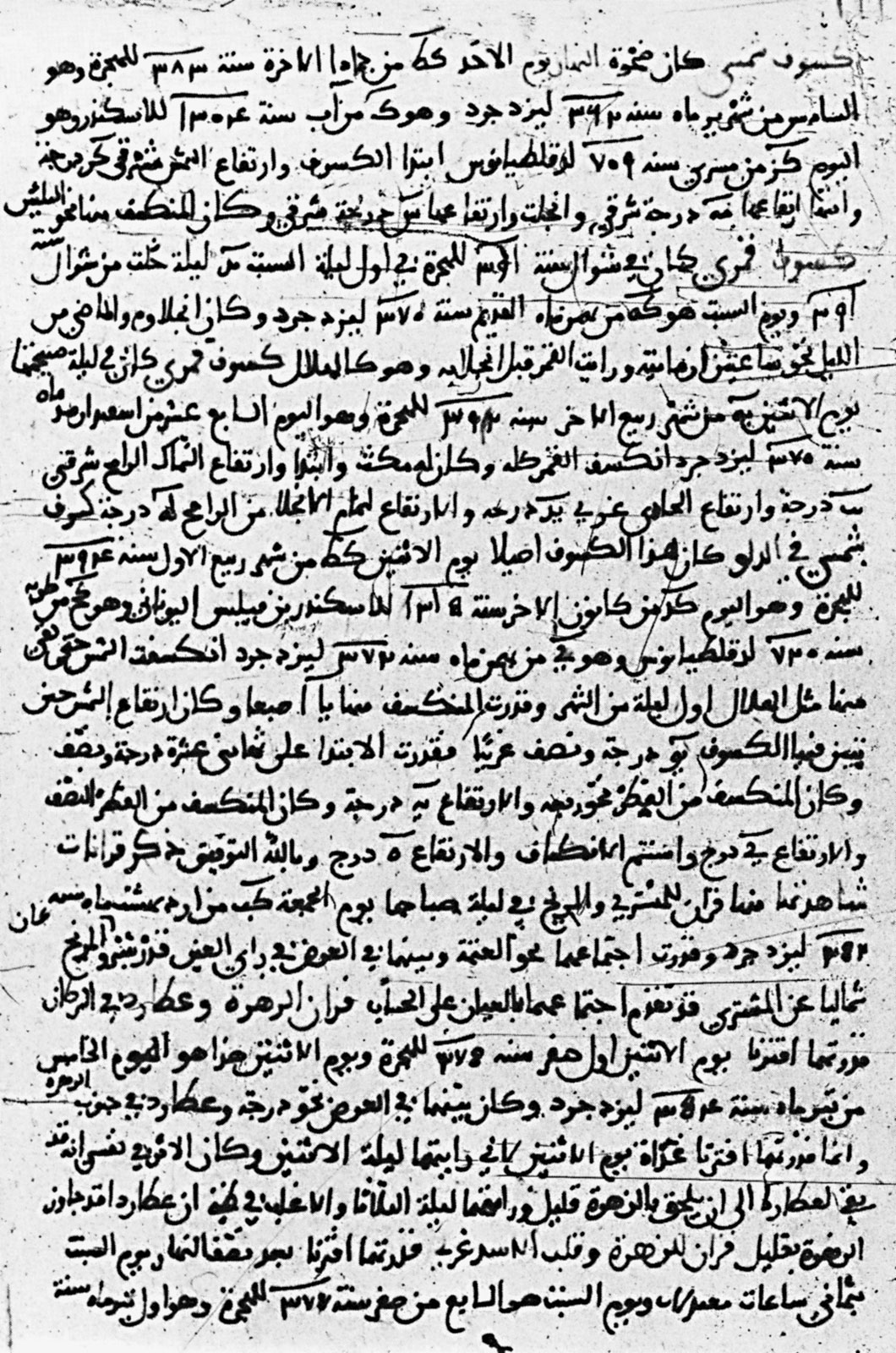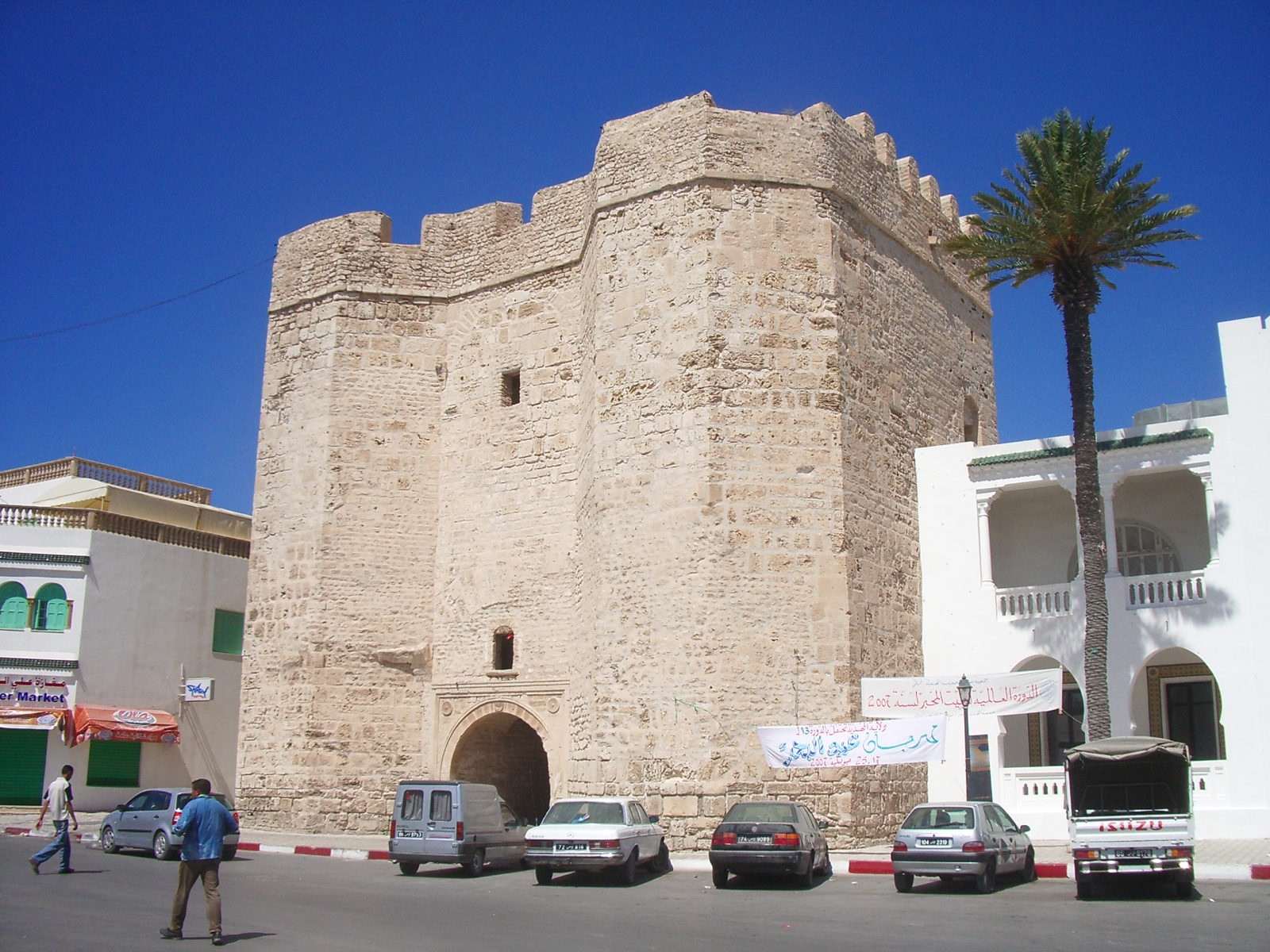|
Ibn Yunis
Abu al-Hasan 'Ali ibn Abi al-Said 'Abd al-Rahman ibn Ahmad ibn Yunus ibn Abd al-'Ala al-Sadafi al-Misri (Egyptian Arabic: ابن يونس; c. 950 – 1009) was an important Arab Egyptian astronomer and mathematician, whose works are noted for being ahead of their time, having been based on meticulous calculations and attention to detail. He is one of the famous Muslim astronomers who appeared after Al-Battani and Abu al-Wafa' al-Buzjani, and he was perhaps the greatest astronomer of his time. Because of his brilliance, the Fatimids gave him generous gifts and established an observatory for him on Mount Mokattam near Fustat. Al-Aziz Billah ordered him to make astronomical tables, which he completed during the reign of Al-Hakim bi-Amr Allah, son of Al-Aziz, and called it al-Zij al-Kabir al-Hakimi. The crater Ibn Yunus on the Moon is named after him. Life Information regarding his early life and education is uncertain. He was born in Egypt between 950 and 952 and came from a respe ... [...More Info...] [...Related Items...] OR: [Wikipedia] [Google] [Baidu] |
Fustat
Fustat (), also Fostat, was the first capital of Egypt under Muslim rule, though it has been integrated into Cairo. It was built adjacent to what is now known as Old Cairo by the Rashidun Muslim general 'Amr ibn al-'As immediately after the Muslim conquest of Egypt in AD 641, and featured the Mosque of Amr, the first mosque built in Egypt. The city reached its peak in the 12th century, with a population of approximately 200,000.Williams, p. 37 It was the centre of administrative power in Egypt, until it was ordered burnt in 1168 by its own vizier, Shawar, to keep its wealth out of the hands of the invading Crusaders. The remains of the city were eventually absorbed by nearby Cairo, which had been built to the north of Fustat in 969 when the Fatimids conquered the region and created a new city as a royal enclosure for the Caliph. The area fell into disrepair for hundreds of years and was used as a rubbish dump. Today, Fustat is a suburb that lies within the modern district of O ... [...More Info...] [...Related Items...] OR: [Wikipedia] [Google] [Baidu] |
Al-Aziz Billah
Abu Mansur Nizar (; 10 May 955 – 14 October 996), known by his regnal name as al-Aziz Billah (), was the fifth caliph of the Fatimid dynasty, from 975 to his death in 996. His reign saw the capture of Damascus and the Fatimid expansion into the Levant, which brought al-Aziz into conflict with the Byzantine emperor Basil II over control of Aleppo. During the course of this expansion, al-Aziz took into his service large numbers of Turkic and Daylamite slave-soldiers, thereby breaking the near-monopoly on Fatimid military power held until then by the Kutama Berbers. Biography Nizar, the future al-Aziz Billah, was born on 10 May 955, the third son of the fourth Fatimid Caliph, al-Mu'izz li-Din Allah (). His mother, Durzan, usually known as ('the Lady of al-Mu'izz') was the chief concubine of al-Mu'izz, and likely of Bedouin origin. She was known for her beautiful singing voice, which earned her the nickname ('Twitter'). She is also recorded as the first Fatimid female pat ... [...More Info...] [...Related Items...] OR: [Wikipedia] [Google] [Baidu] |
Coptic Calendar
The Coptic calendar, also called the Alexandrian calendar, is a liturgical calendar used by the farming populace in Egypt and used by the Coptic Orthodox and Coptic Catholic churches. It was used for fiscal purposes in Egypt until the adoption of the Gregorian calendar on 11 September 1875 (1st Thout 1592 AM). This calendar is based on the ancient Egyptian calendar. To avoid the calendar creep of the latter (which contained only 365 days each year, year after year, so that the seasons shifted about one day every four years), a reform of the ancient Egyptian calendar was introduced at the time of Ptolemy III ( Decree of Canopus, in 238 BC) which consisted of adding an extra day every fourth year. However, this reform was opposed by the Egyptian priests, and the reform was not adopted until 25 BC, when the Roman Emperor Augustus imposed the Decree upon Egypt as its official calendar (although initially, namely between 25 BC and AD 5, it was unsynchronised with the original i ... [...More Info...] [...Related Items...] OR: [Wikipedia] [Google] [Baidu] |
Sirius
Sirius is the brightest star in the night sky. Its name is derived from the Greek word (Latin script: ), meaning 'glowing' or 'scorching'. The star is designated Canis Majoris, Latinized to Alpha Canis Majoris, and abbreviated CMa or Alpha CMa. With a visual apparent magnitude of −1.46, Sirius is almost twice as bright as Canopus, the next brightest star. Sirius is a binary star consisting of a main-sequence star of spectral type A0 or A1, termed Sirius A, and a faint white dwarf companion of spectral type DA2, termed Sirius B. The distance between the two varies between 8.2 and 31.5 astronomical units as they orbit every 50 years. Sirius appears bright because of its intrinsic luminosity and its proximity to the Solar System. At a distance of , the Sirius system is one of Earth's nearest neighbours. Sirius is gradually moving closer to the Solar System and it is expected to increase in brightness slightly over t ... [...More Info...] [...Related Items...] OR: [Wikipedia] [Google] [Baidu] |
Heliacal Rising
The heliacal rising ( ) of a star or a planet occurs annually when it becomes visible above the eastern horizon at dawn just before sunrise (thus becoming "the Morning Star (other)#Astronomy, morning star"). A heliacal rising marks the time when a star or planet becomes visible for the first time again in the night sky after having set with the Sun at the western horizon in a previous sunset (its heliacal setting), having since been in the sky only during daytime, obscured by sunlight. Historically, the most important such rising is that of Sirius, which was an important feature of the Egyptian calendar and Egyptian astronomy, astronomical development. The rising of the Pleiades heralded the start of the Ancient Greek sailing season, using celestial navigation, as well as the farming season (attested by Hesiod in his Works and Days). Heliacal rising is one of several types of risings and settings, mostly they are grouped into morning and evening risings and settings of obj ... [...More Info...] [...Related Items...] OR: [Wikipedia] [Google] [Baidu] |
Astrology
Astrology is a range of Divination, divinatory practices, recognized as pseudoscientific since the 18th century, that propose that information about human affairs and terrestrial events may be discerned by studying the apparent positions of Celestial objects in astrology, celestial objects. Different cultures have employed forms of astrology since at least the 2nd millennium BCE, these practices having originated in Calendrical calculation, calendrical systems used to predict seasonal shifts and to interpret celestial cycles as signs of divine communications. Most, if not all, cultures have attached importance to what they observed in the sky, and some—such as the Hindu astrology, Hindus, Chinese astrology, Chinese, and the Maya civilization, Maya—developed elaborate systems for predicting terrestrial events from celestial observations. Western astrology, one of the oldest astrological systems still in use, can trace its roots to 19th–17th century BCE Mesopotamia, fr ... [...More Info...] [...Related Items...] OR: [Wikipedia] [Google] [Baidu] |
Fatimid Dynasty
The Fatimid dynasty () was an Arab dynasty that ruled the Fatimid Caliphate, between 909 and 1171 CE. Descended from Fatima and Ali, and adhering to Isma'ili Shi'ism, they held the Isma'ili imamate, and were regarded as the rightful leaders of the Muslim community. The line of Nizari Isma'ili imams, represented today by the Aga Khans, claims descent from a branch of the Fatimids. The Alavi Bohras, predominantly based in Vadodara, also claim descent from the Fatimids. The Fatimid dynasty emerged as the leaders of the clandestine early Isma'ili missionary movement () in the ninth century CE, ostensibly acting on behalf of a hidden imam, implied at the time to be Muhammad ibn Isma'il. The Isma'ili spread widely across the Islamic world, then ruled by the Abbasid Caliphate. In 899, the future first Fatimid caliph, Abdallah, proclaimed himself to be the expected imam, causing a rift in the Isma'ili as the Qarmatians, who did not recognize his imamate, split off. In the meanti ... [...More Info...] [...Related Items...] OR: [Wikipedia] [Google] [Baidu] |
Al-Shafi'i
Al-Shafi'i (; ;767–820 CE) was a Muslim scholar, jurist, muhaddith, traditionist, theologian, ascetic, and eponym of the Shafi'i school of Sunni Islamic jurisprudence. He is known to be the first to write a book upon the principles of Islamic jurisprudence, having authored one of the earliest work on the subject: '' al-Risala''. His legacy and teaching on the matter provided it with a systematic form, thereby "fundamentally influencing the succeeding generations which are under his direct and obvious impact," and "beginning a new phase of the development of legal theory." Being born in Gaza, Palestine, to the Banu Muttalib clan of the Quraysh tribe, he relocated at the age of two and was raised in Mecca. He later resided in Medina, Yemen, Baghdad in Iraq, and Egypt, and also served as a judge for some time in Najran. Introduction The biography of al-Shafi'i is difficult to trace. It was said Dawud al-Zahiri (d. 884 CE) was the first to write one, but the work ... [...More Info...] [...Related Items...] OR: [Wikipedia] [Google] [Baidu] |
George Sarton
George Alfred Leon Sarton (; 31 August 1884 – 22 March 1956) was a Belgian-American chemist and historian. He is considered the founder of the discipline of the history of science as an independent field of study. His most influential works were the ''Introduction to the History of Science'', which consists of three volumes and 4,296 pages, and the journal ''Isis''. Sarton ultimately aimed to achieve an integrated philosophy of science that provided a connection between the sciences and the humanities, which he referred to as "the new humanism". Life and work George Alfred Leon Sarton was born to Léonie Van Halmé and Alfred Sarton on August 31, 1884 in Ghent, East Flanders, Belgium. However, within a year of his birth, Sarton's mother died. He attended school first in his hometown before later attending school for a period of four years in the town of Chimay. Sarton enrolled at the University of Ghent in 1902 to study philosophy, but found that the subject did not correspond ... [...More Info...] [...Related Items...] OR: [Wikipedia] [Google] [Baidu] |
Hadith
Hadith is the Arabic word for a 'report' or an 'account f an event and refers to the Islamic oral tradition of anecdotes containing the purported words, actions, and the silent approvals of the Islamic prophet Muhammad or his immediate circle ( companions in Sunni Islam, Ahl al-Bayt in Shiite Islam). Each hadith is associated with a chain of narrators ()—a lineage of people who reportedly heard and repeated the hadith from which the source of the hadith can be traced. The authentication of hadith became a significant discipline, focusing on the ''isnad'' (chain of narrators) and '' matn'' (main text of the report). This process aimed to address contradictions and questionable statements within certain narrations. Beginning one or two centuries after Muhammad's death, Islamic scholars, known as muhaddiths, compiled hadith into distinct collections that survive in the historical works of writers from the second and third centuries of the Muslim era ( 700−1000 CE). For ... [...More Info...] [...Related Items...] OR: [Wikipedia] [Google] [Baidu] |






